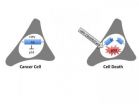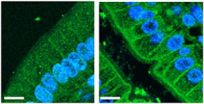(Press-News.org) Perhaps no aspect of 3D printing has captured the popular imagination more than personalized figurines with the facial features of real people. Now, researchers at Disney Research Zurich and the University of Zaragoza have developed a method that can incorporate an individual's hairstyle as well.
The researchers will present their new method at ACM SIGGRAPH 2014, the International Conference on Computer Graphics and Interactive Techniques in Vancouver, Aug. 10-14.
Miniature statues with a person's likeness are nowadays produced by scanning the individual's face with a depth camera or other sensor to create a 3D model. These facial features can then be applied to a figure that is produced on a 3D printer. But hair is beyond the capabilities of most systems, so hairstyles either must be roughly approximated or replaced with a pre-existing template.
The result can leave much to be desired, said Dr. Derek Bradley, associate research scientist at Disney Research Zurich.
"Almost as much as the face, a person's hairstyle is a defining characteristic of an individual," he explained. "The resulting figurine loses a degree of realism when the individual's hairstyle isn't adequately captured."
The goal is not to reproduce a hairstyle fiber by fiber, as this level of complexity cannot be miniaturized using current 3D printers. Rather, the researchers were inspired by artistic
sculptures, such as Michelangelo's David, which reproduce the essence of a hairstyle, but in the solid form of a helmet. In the case of 3D-printed figurines, the researchers sought to retain the appearance of directional wisps and the overall flow of hair, as well as its color.
Beginning with several color images captured of the subject's head, the system first computes a coarse geometry for the surface of the hair. Color information from the images is then added, matching the colors to the rough geometry to the extent possible. In the next step, color stylization, the level of detail is reduced enough to enable the representation to be miniaturized and reproduced, while preserving the hairstyle's defining features. Finally, geometric details are added in a way that is consistent with the color stylization.
The researchers demonstrated the system by capturing the varying hairstyles of several people, including two people who each were scanned with four different hairstyles. In each reproduction, the hairstyles are identifiable and recognizably the same as when the subject's image was captured. The method even enabled facial hair and fur to be reproduced.
INFORMATION:
In addition to Bradley, the research team included Dr. Thabo Beeler of Disney Research Zurich and Jose I. Echevarria, a Ph.D. student who interned at the Disney lab, and Dr. Diego Gutierrez, both of the University of Zaragoza, Spain.
More information, including a video, is available on the project web site at http://www.disneyresearch.com/project/stylized-hair-capture/.
About Disney Research
Disney Research is a network of research laboratories supporting The Walt Disney Company. Its purpose is to pursue scientific and technological innovation to advance the company's broad media and entertainment efforts. Vice Presidents Jessica Hodgins and Markus Gross manage Disney Research facilities in Los Angeles, Pittsburgh, Zürich, and Boston and work closely with the Pixar and ILM research groups in the San Francisco Bay Area. Research topics include computer graphics, animation, video processing, computer vision, robotics, wireless & mobile computing, human-computer interaction, displays, behavioral economics, and machine learning.
Disney Researchers develop method to capture stylized hair for 3-D-printed figurines
Hairstyle is a defining characteristic second only to the face
2014-08-08
ELSE PRESS RELEASES FROM THIS DATE:
Expecting to teach enhances learning, recall
2014-08-08
"When compared to learners expecting a test, learners expecting to teach recalled more material correctly, they organized their recall more effectively and they had better memory for especially important information," said lead author John Nestojko, PhD, a postdoctoral researcher in psychology in Arts & Sciences at WUSTL.
The study, published recently in the journal Memory & Cognition, is based on a series of reading-and-recall experiments in which one group of students is told they will be tested on a selection of written material, and another group is led to believe ...
Water's reaction with metal oxides opens doors for researchers
2014-08-08
MADISON, Wis. — A multi-institutional team has resolved a long-unanswered question about how two of the world's most common substances interact.
In a paper published recently in the journal Nature Communications, Manos Mavrikakis, professor of chemical and biological engineering at the University of Wisconsin-Madison, and his collaborators report fundamental discoveries about how water reacts with metal oxides. The paper opens doors for greater understanding and control of chemical reactions in fields ranging from catalysis to geochemistry and atmospheric chemistry.
"These ...
Editing HPV's genes to kill cervical cancer cells
2014-08-08
DURHAM, N.C. -- Researchers have hijacked a defense system normally used by bacteria to fend off viral infections and redirected it against the human papillomavirus (HPV), the virus that causes cervical, head and neck, and other cancers.
Using the genome editing tool known as CRISPR, the Duke University researchers were able to selectively destroy two viral genes responsible for the growth and survival of cervical carcinoma cells, causing the cancer cells to self-destruct.
The findings, appearing online August 7 in the Journal of Virology, give credence to an approach ...
UK study shows promise for new nerve repair technique
2014-08-08
LEXINGTON, Ky. (Aug. 8, 2014) – A multicenter study including University of Kentucky researchers found that a new nerve repair technique yields better results and fewer side effects than other existing techniques.
Traumatic nerve injuries are common, and when nerves are severed, they do not heal on their own and must be repaired surgically. Injuries that are not clean-cut – such as saw injuries, farm equipment injuries, and gunshot wounds – may result in a gap in the nerve.
To fill these gaps, surgeons have traditionally used two methods: a nerve autograft (bridging ...
Ancient shellfish remains rewrite 10,000-year history of El Nino cycles
2014-08-08
The planet's largest and most powerful driver of climate changes from one year to the next, the El Niño Southern Oscillation in the tropical Pacific Ocean, was widely thought to have been weaker in ancient times because of a different configuration of the Earth's orbit. But scientists analyzing 25-foot piles of ancient shells have found that the El Niños 10,000 years ago were as strong and frequent as the ones we experience today.
The results, from the University of Washington and University of Montpellier, question how well computer models can reproduce historical El ...
Kessler Foundation scientists confirm effectiveness of cognitive rehabilitation in MS
2014-08-08
WEST ORANGE, NJ August 8, 2014. Kessler Foundation researchers published long-term followup results of their MEMREHAB trial, which show that in individuals with MS, patterns of brain activity associated with learning were maintained at 6 months post training. The article, A pilot study examining functional brain activity 6 months after memory retraining in MS: the MEMREHAB trial, was published online ahead of print on June 14 by Brain Imaging and Behavior (doi: 10.1007/s11682-014-9309-9). The article appeared in the Neuroimaging and Rehabilitation Special Issue. The authors ...
Photo editing algorithm changes weather, seasons automatically
2014-08-08
PROVIDENCE, R.I. [Brown University] — We may not be able control the weather outside, but thanks to a new algorithm being developed by Brown University computer scientists, we can control it in photographs.
The new program enables users to change a suite of "transient attributes" of outdoor photos — the weather, time of day, season, and other features — with simple, natural language commands. To make a sunny photo rainy, for example, just input a photo and type, "more rain." A picture taken in July can be made to look a bit more January simply by typing "more winter." ...
Natural light in office boosts health
2014-08-08
CHICAGO -- Office workers with more light exposure at the office had longer sleep duration, better sleep quality, more physical activity and better quality of life compared to office workers with less light exposure in the workplace, reports a new study from Northwestern Medicine and the University of Illinois at Urbana-Champaign.
The study highlights the importance of exposure to natural light to employee health and the priority architectural designs of office environments should place on natural daylight exposure for workers, the study authors said.
Employees with ...
New culprit identified in metabolic syndrome
2014-08-08
A new study suggests uric acid may play a role in causing metabolic syndrome, a cluster of risk factors that increases the risk of heart disease and type 2 diabetes.
Uric acid is a normal waste product removed from the body by the kidneys and intestines and released in urine and stool. Elevated levels of uric acid are known to cause gout, an accumulation of the acid in the joints. High levels also are associated with the markers of metabolic syndrome, which is characterized by obesity, high blood pressure, elevated blood sugar and high cholesterol. But it has been unclear ...
Musical training offsets some academic achievement gaps, research says
2014-08-08
WASHINGTON -- Learning to play a musical instrument or to sing can help disadvantaged children strengthen their reading and language skills, according to research presented at the American Psychological Association's 122nd Annual Convention.
The findings, which involved hundreds of kids participating in musical training programs in Chicago and Los Angeles public schools, highlight the role learning music can have on the brains of youth in impoverished areas, according to presenter Nina Kraus, PhD, a neurobiologist at Northwestern University.
"Research has shown that ...
LAST 30 PRESS RELEASES:
Injectable breast ‘implant’ offers alternative to traditional surgeries
Neuroscientists devise formulas to measure multilingualism
New prostate cancer trial seeks to reduce toxicity without sacrificing efficacy
Geometry shapes life
A CRISPR screen reveals many previously unrecognized genes required for brain development and a new neurodevelopmental disorder
Hot flush treatment has anti-breast cancer activity, study finds
Securing AI systems against growing cybersecurity threats
Longest observation of an active solar region
Why nail-biting, procrastination and other self-sabotaging behaviors are rooted in survival instincts
Regional variations in mechanical properties of porcine leptomeninges
Artificial empathy in therapy and healthcare: advancements in interpersonal interaction technologies
Why some brains switch gears more efficiently than others
UVA’s Jundong Li wins ICDM’S 2025 Tao Li Award for data mining, machine learning
UVA’s low-power, high-performance computer power player Mircea Stan earns National Academy of Inventors fellowship
Not playing by the rules: USU researcher explores filamentous algae dynamics in rivers
Do our body clocks influence our risk of dementia?
Anthropologists offer new evidence of bipedalism in long-debated fossil discovery
Safer receipt paper from wood
Dosage-sensitive genes suggest no whole-genome duplications in ancestral angiosperm
First ancient human herpesvirus genomes document their deep history with humans
Why Some Bacteria Survive Antibiotics and How to Stop Them - New study reveals that bacteria can survive antibiotic treatment through two fundamentally different “shutdown modes”
UCLA study links scar healing to dangerous placenta condition
CHANGE-seq-BE finds off-target changes in the genome from base editors
The Journal of Nuclear Medicine Ahead-of-Print Tip Sheet: January 2, 2026
Delayed or absent first dose of measles, mumps, and rubella vaccination
Trends in US preterm birth rates by household income and race and ethnicity
Study identifies potential biomarker linked to progression and brain inflammation in multiple sclerosis
Many mothers in Norway do not show up for postnatal check-ups
Researchers want to find out why quick clay is so unstable
Superradiant spins show teamwork at the quantum scale
[Press-News.org] Disney Researchers develop method to capture stylized hair for 3-D-printed figurinesHairstyle is a defining characteristic second only to the face




